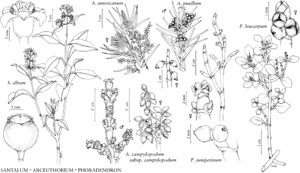Santalum
Sp. Pl. 2: 349. 1753.
Trees [shrubs], evergreen, synoecious. Stems glabrous. Leaves: petiole well developed. Inflorescences axillary and terminal, thyrses [cymes, racemes, umbels]. Pedicels present. Flowers bisexual; perianth and androecium perigynous [epigynous]; hypanthium campanulate [very short, funnelform, cylindric]; petals 4; nectary lining hypanthium, lobed distally; stamens 4, with hairs at filament base; ovary 1/2-inferior to almost superior [inferior], 1-locular; ovules 2–4; styles long, cylindric [short]; stigmas 3-lobed. Pseudodrupes rimmed by circular collar (scar or perianth remnants) at apex. x = 10.
Distribution
Introduced; Fla., Asia (Indonesia), Pacific Islands (Papua New Guinea), Australia, also elsewhere in Asia (India)
Discussion
Species 15 (1 in the flora).
Selected References
None.
